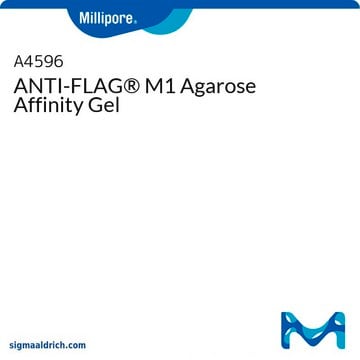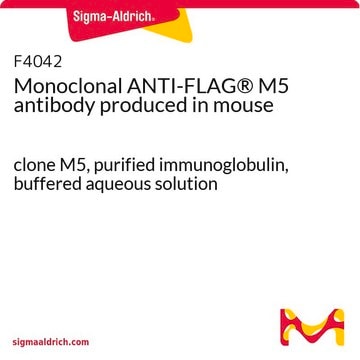F3040
Monoclonal ANTI-FLAG® M1 antibody produced in mouse
clone M1, purified immunoglobulin, buffered aqueous solution
Synonim(y):
Anti-ddddk, Anti-dykddddk
About This Item
Polecane produkty
pochodzenie biologiczne
mouse
białko sprzężone
unconjugated
forma przeciwciała
purified immunoglobulin
rodzaj przeciwciała
primary antibodies
klon
M1, monoclonal
Postać
buffered aqueous solution
oczyszczone przez
using Protein A
reaktywność gatunkowa
all
stężenie
2-5 mg/mL
metody
western blot: 10 μg/mL
sekwencja immunogenna
DYKDDDDK
Warunki transportu
dry ice
temp. przechowywania
−20°C
Powiązane kategorie
Opis ogólny
Method of purification - Protein A
Immunogen
Zastosowanie
Applications in which this antibody has been used successfully, and the associated peer-reviewed papers, are given below.
Chromatin immunoprecipitation (1 paper)
Immunofluorescence (1 paper)
Learn more product details in our FLAG® applications portal.
Działania biochem./fizjol.
Postać fizyczna
Uwaga dotycząca przygotowania
Informacje prawne
Not finding the right product?
Try our Narzędzie selektora produktów.
Kod klasy składowania
10 - Combustible liquids
Klasa zagrożenia wodnego (WGK)
WGK 1
Temperatura zapłonu (°F)
Not applicable
Temperatura zapłonu (°C)
Not applicable
Certyfikaty analizy (CoA)
Poszukaj Certyfikaty analizy (CoA), wpisując numer partii/serii produktów. Numery serii i partii można znaleźć na etykiecie produktu po słowach „seria” lub „partia”.
Masz już ten produkt?
Dokumenty związane z niedawno zakupionymi produktami zostały zamieszczone w Bibliotece dokumentów.
Klienci oglądali również te produkty
Nasz zespół naukowców ma doświadczenie we wszystkich obszarach badań, w tym w naukach przyrodniczych, materiałoznawstwie, syntezie chemicznej, chromatografii, analityce i wielu innych dziedzinach.
Skontaktuj się z zespołem ds. pomocy technicznej













